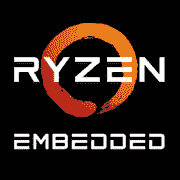AMD Ryzen Embedded V3C16

AMD Ryzen Embedded V3C16: A Hybrid of Power and Energy Efficiency for Specialized Solutions
Overview of the processor for embedded systems, IoT, and more (March 2025)
Key Features: Rembrandt in Miniature
The AMD Ryzen Embedded V3C16 processor, built on the Zen 3+ architecture (codename Rembrandt), offers a compact solution for tasks where balancing performance and power consumption is critical.
Process Technology and Cores
- 6 nm technology: Reduces heat output while maintaining high transistor density.
- 6 cores / 12 threads: Multithreaded performance for parallel tasks.
- 16 MB L3 cache: Reduces latency when working with data.
- 15 W TDP: Ideal for passive cooling and compact systems.
Key Features
- Radeon RDNA 2 Graphics: Integrated graphics with 4-6 compute units supporting 4K/60 Hz.
- PCIe 4.0: Up to 20 lanes for connecting NVMe, network cards, or GPUs.
- AMD Secure Processor: Hardware data protection including TPM 2.0 encryption.
Compatible Motherboards: Sockets and Chipsets
The processor targets the embedded market, and thus the choice of motherboards is limited to specialized solutions.
Socket FP7
- Form factors: Mini-ITX, Nano-ITX, COM Express.
- Examples of boards:
- ASRock Industrial IMB-V3C16 (Mini-ITX, 2x DDR5, 4x USB 3.2, price ~ $250).
- Advantech SOM-5992 (COM Express module, starting price $400).
Chipsets
- A-series (Promontory 2): Optimized for embedded solutions, supports up to 4 SATA III, 8 USB 3.2.
Selection Features
- Interfaces: Ensure the presence of HDMI 2.1/DP 1.4 for video output.
- Cooling: Passive heat sinks (e.g., Streacom ST-ZF240) are suitable for a TDP of 15 W.
Memory: DDR5 and LPDDR5
The processor supports modern standards:
- DDR5-4800: Up to 64 GB (2 channels, 32 GB per module).
- LPDDR5-6400: For ultra-compact systems (e.g., tablets or thin clients).
Recommendations
- For embedded PCs: 32 GB DDR5-4800 (e.g., Kingston KVR48S40BD8).
- For energy efficiency: LPDDR5 from SK Hynix (price ~ $120 for 16 GB).
Power Supplies: Minimum Watts, Maximum Reliability
With a TDP of 15 W, a system based on the V3C16 consumes 30-50 W (including storage and peripherals).
Power Supply Selection Tips
- Without discrete graphics: 60-100 W power supplies (e.g., PicoPSU-90, price ~ $70).
- With an external graphics card: 150-200 W (e.g., Seasonic SSP-200SUG, ~$90).
Practical Example
A media server based on the V3C16 with 2x NVMe and passive cooling operates from a PicoPSU-90 + external 12V adapter.
Pros and Cons
Strengths
- Energy efficiency: 15 W with desktop-level CPU performance.
- RDNA 2 graphics: Capable of handling light gaming (Dota 2 at medium settings in 1080p).
- Reliability: Designed for 24/7 operation at temperatures up to 105°C.
Weaknesses
- Limited retail availability: Available through partners (e.g., Arrow Electronics).
- Price: ~$350 for the processor—more expensive than consumer counterparts.
Use Cases
1. Industrial PCs: Machine control, data collection from sensors.
2. Media Centers: Supports AV1 decoding, HDR.
3. Thin Clients: Desktop virtualization (Citrix, VMware).
4. Smart Cameras: Video processing with AI algorithms.
Real-World Case
The company "SmartFactory" implemented the V3C16 in conveyor controllers: power consumption decreased by 40% compared to the Intel i5-1135G7.
Comparison with Competitors
- Intel Core i5-1245U (15 W):
- Pros: Better software compatibility.
- Cons: Weaker graphics (Iris Xe 80 EU), more expensive (~$380).
- NVIDIA Jetson Orin NX (10-20 W):
- Pros: Powerful AI accelerator (100 TOPS).
- Cons: No x86 compatibility, complex development.
Conclusion: The V3C16 excels in hybrid tasks (graphics + computations).
Assembly Tips
1. Case: Choose fanless solutions (e.g., HDPlex H5).
2. Storage: NVMe PCIe 4.0 (e.g., WD SN770 1TB, ~$80).
3. OS: Linux (Ubuntu 24.04 LTS) or Windows 11 IoT.
Beginner's Mistake
Using DDR4 instead of DDR5: the processor does not support outdated memory!
Final Verdict: Who is the V3C16 for?
This processor is designed for:
- Embedded system integrators: Stability and long support life (AMD guarantees 10 years of supply).
- IoT developers: Power of x86 + low power consumption.
- Compact PC enthusiasts: Building a silent media center.
Why choose it?
The V3C16 combines modern technologies (DDR5, PCIe 4.0) and unique RDNA 2 graphics for the embedded segment, making it a versatile solution in the "small hardware" niche.
Prices are current as of March 2025. Listed for new devices.
Basic
CPU Specifications
Memory Specifications
GPU Specifications
Share in social media
Or Link To Us
<a href="https://cputronic.com/en/cpu/amd-ryzen-embedded-v3c16" target="_blank">AMD Ryzen Embedded V3C16</a>